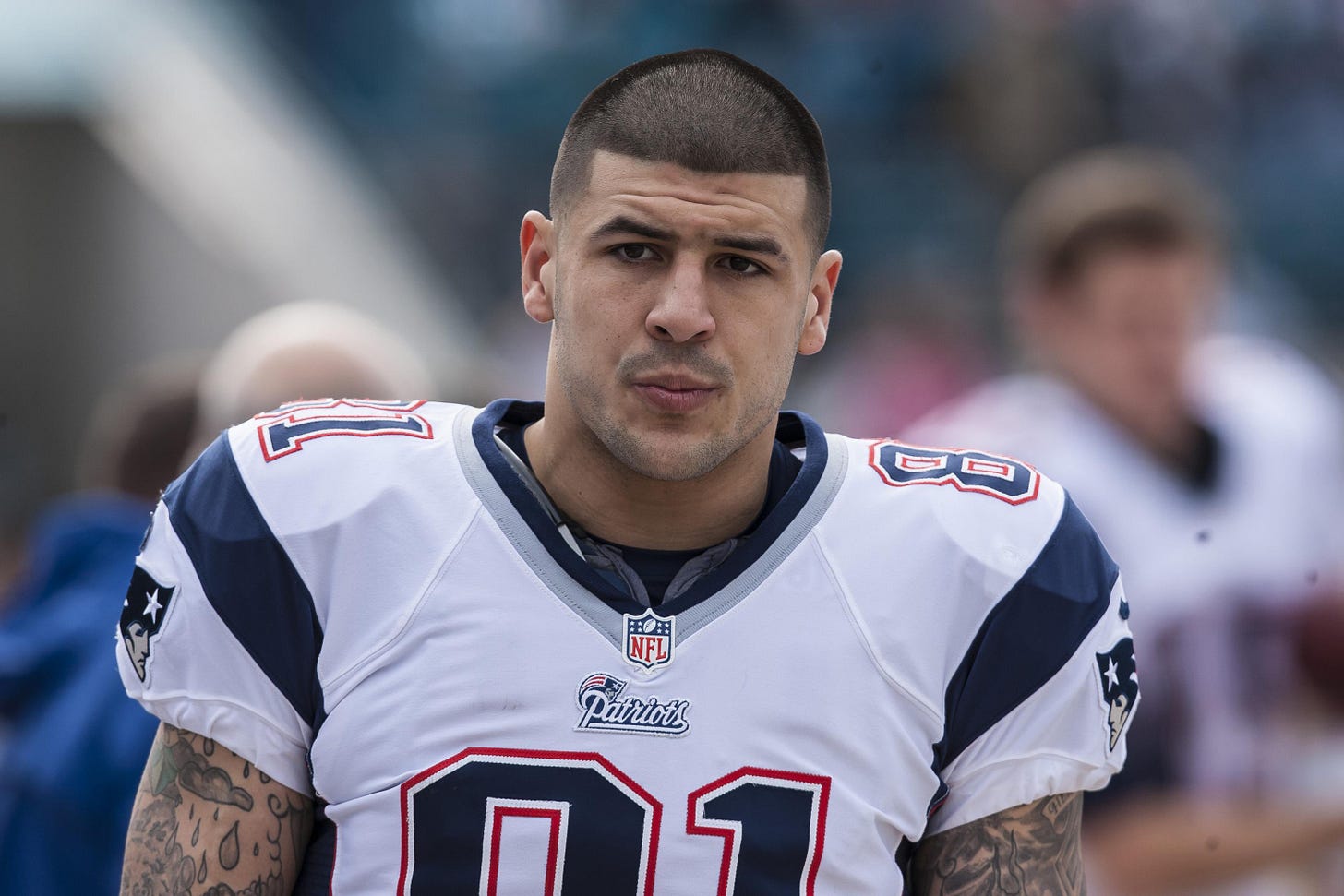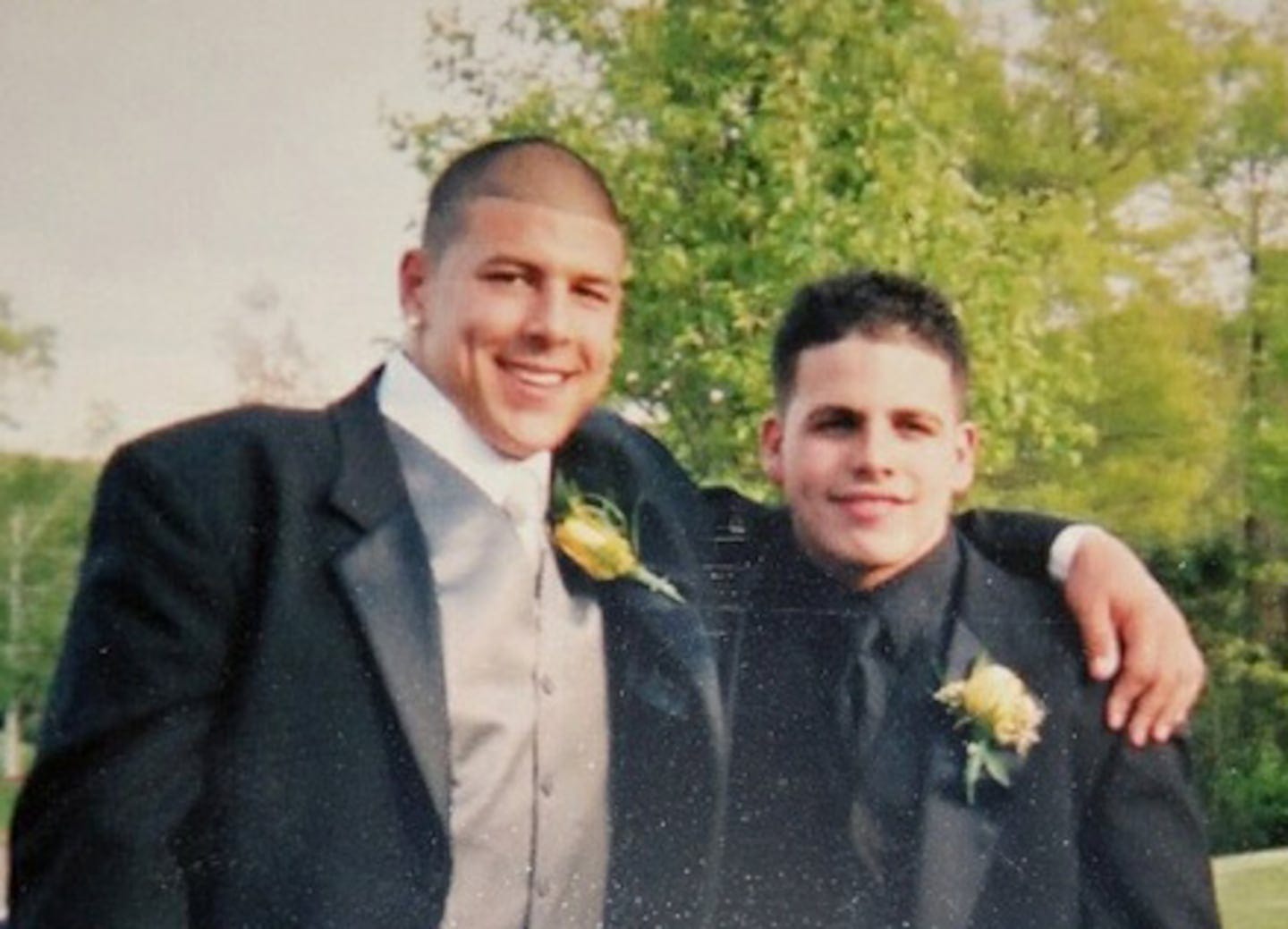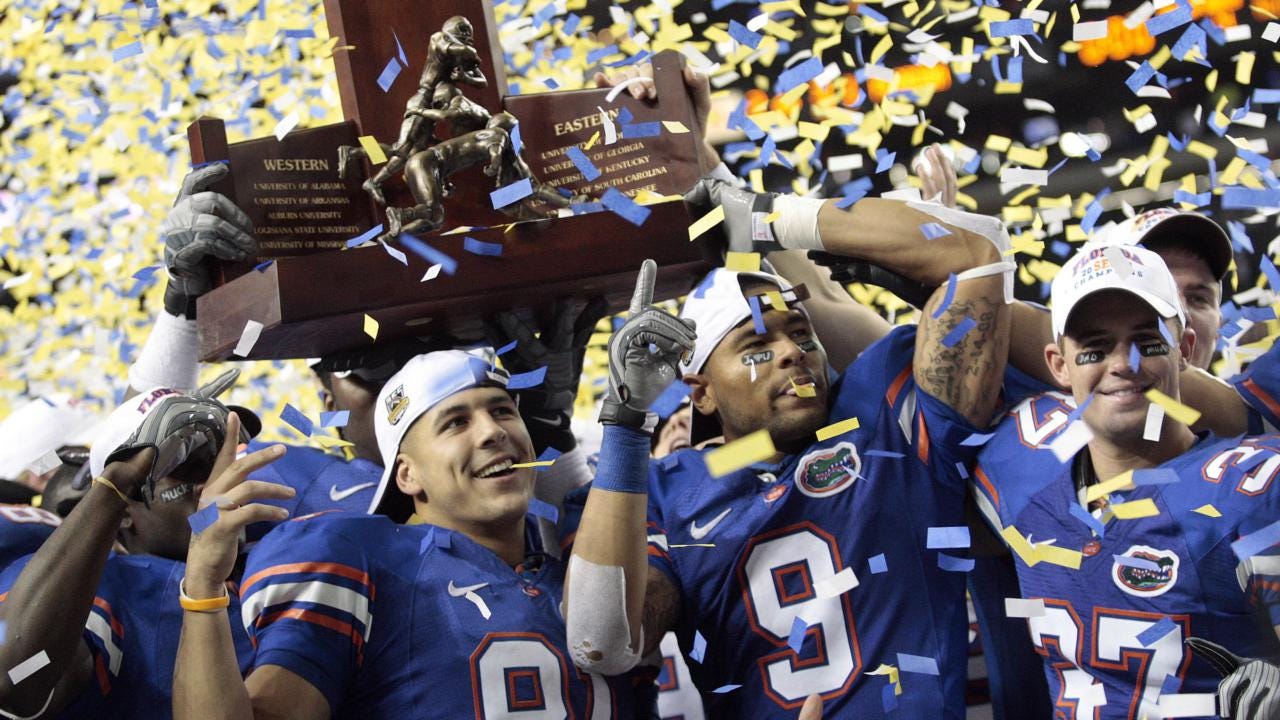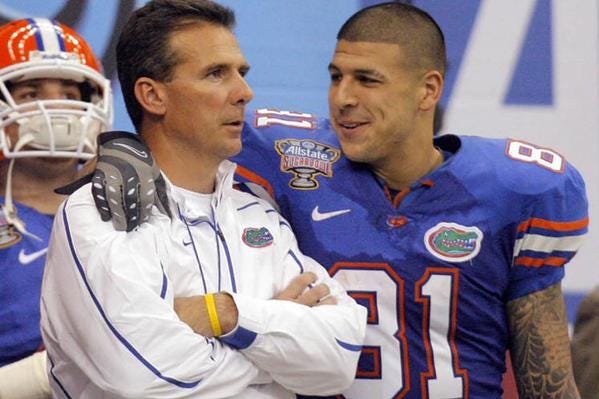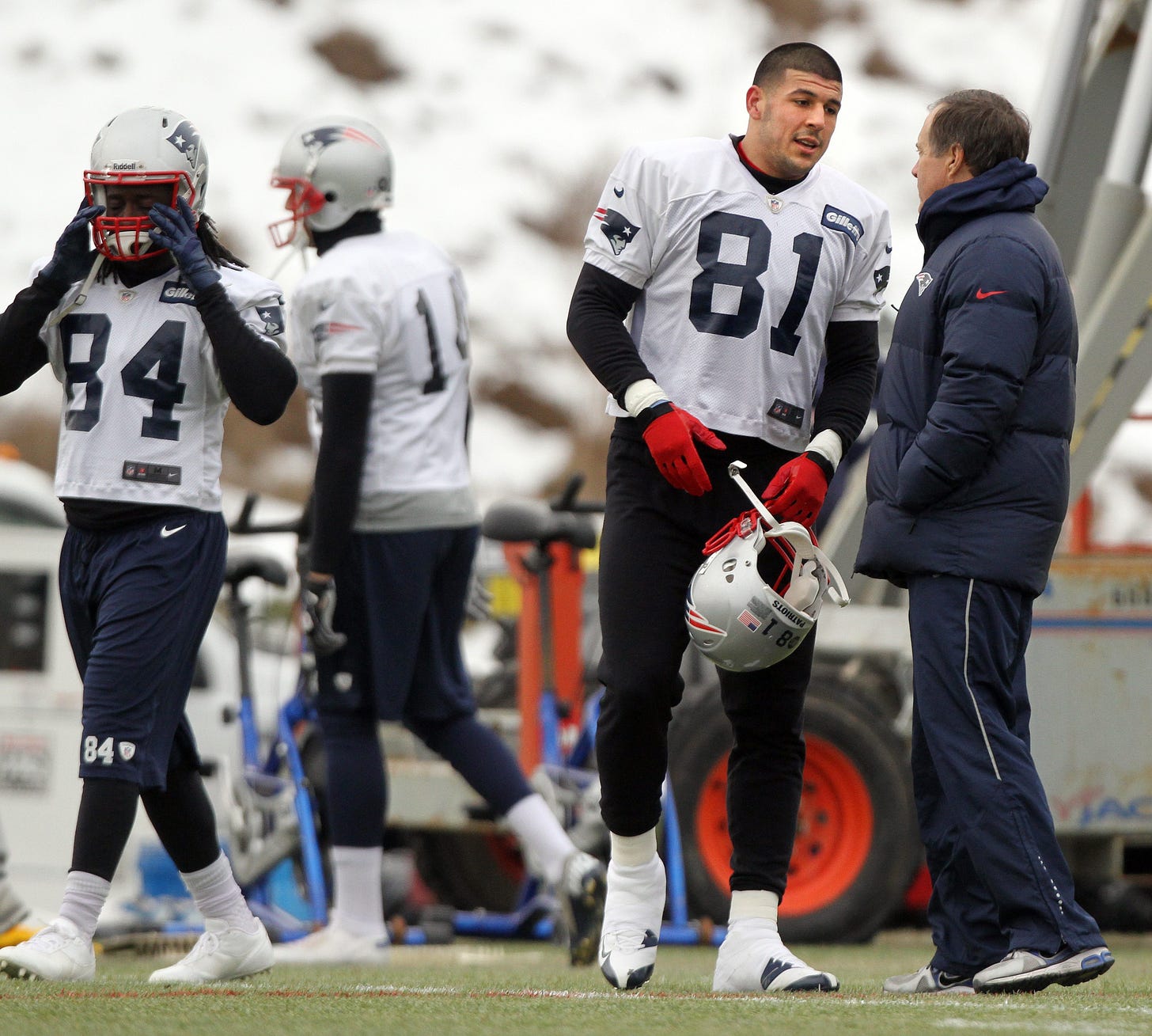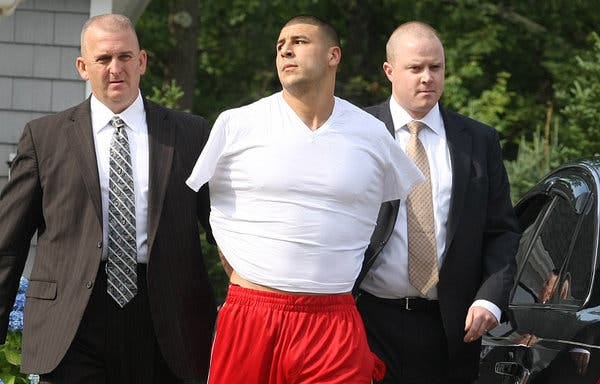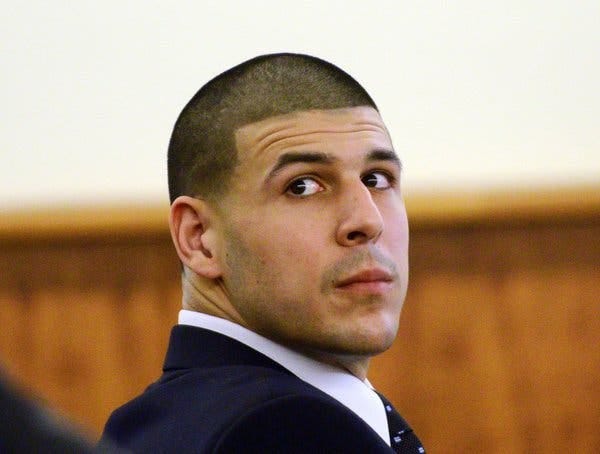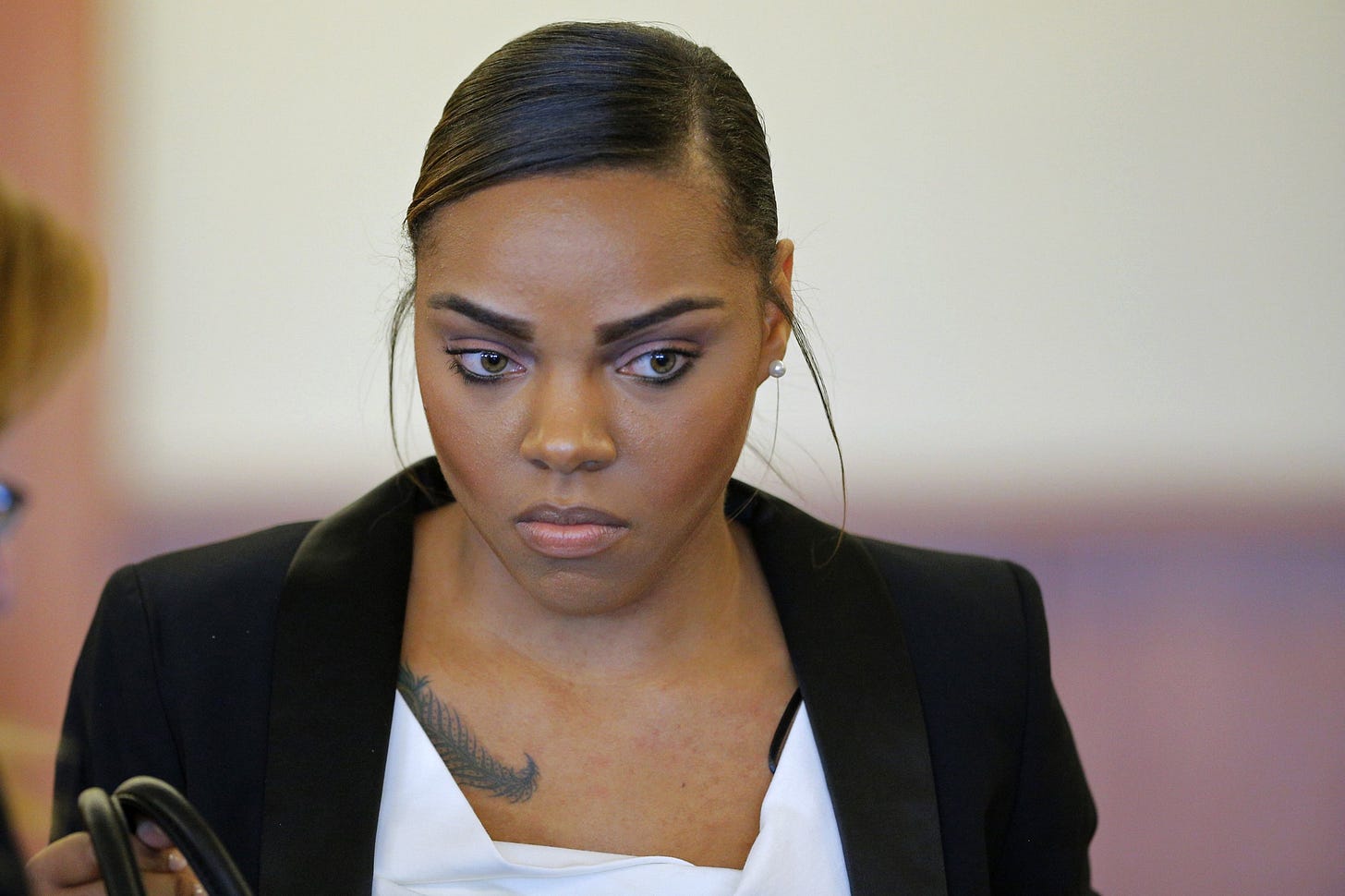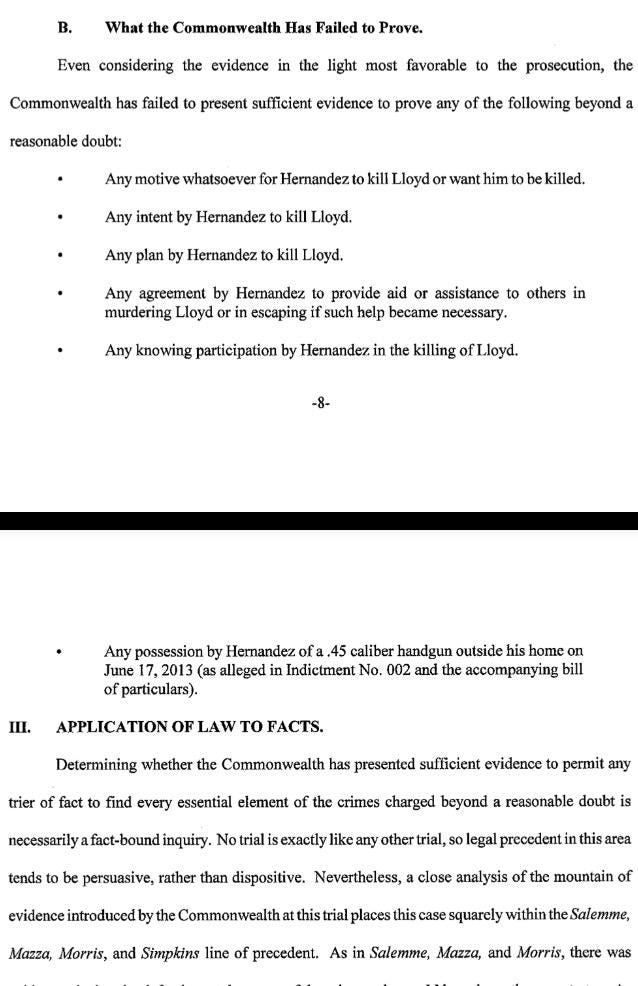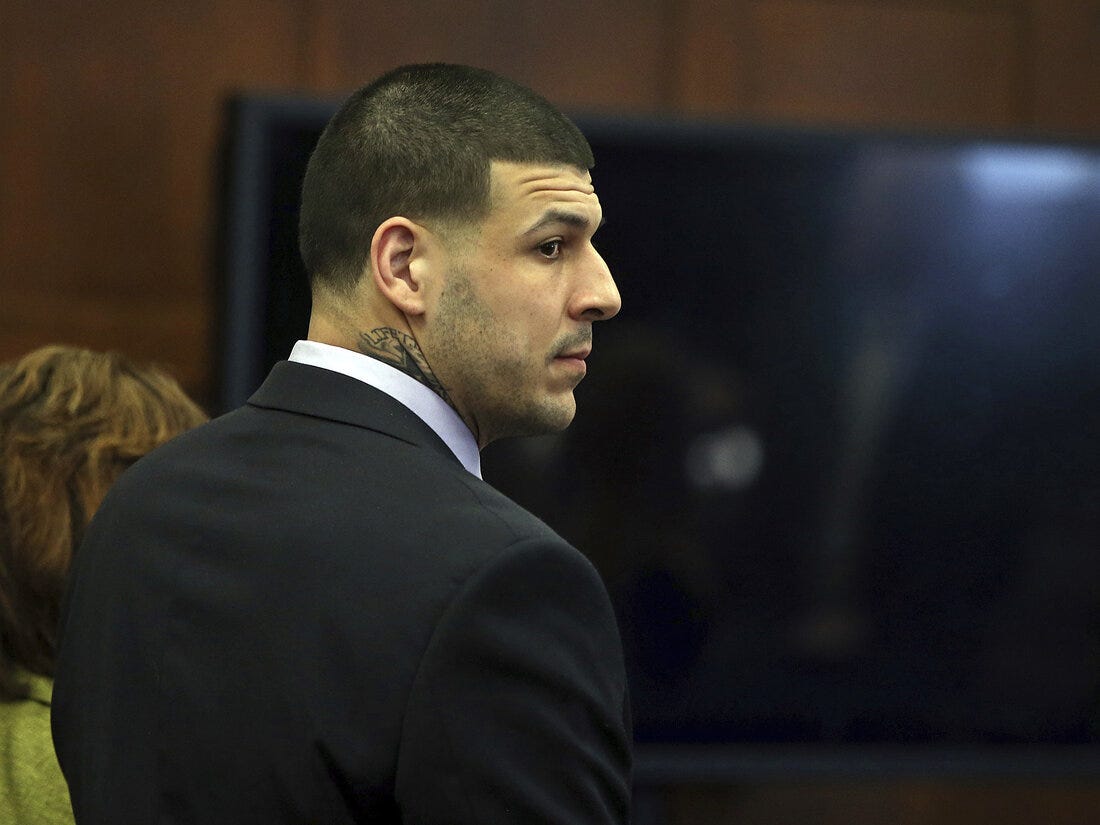DSOTG #1: Aaron Hernandez
Football star Aaron Hernandez went from being in the bright lights of Gillette Stadium, to spending the remainder of his short life behind bars.
TW: Suicide, Abuse, Drugs, Alcohol, Slurs, Murder — Viewer discretion is advised.
(Photo Credit: Bleacher Report)
At just 27-years old, Odin Lloyd was an aspiring professional athlete, playing linebacker for the Boston Bandits of the New England Football League. That all came to an abrupt halt when Lloyd was shot dead in North Attleborough, Massachusetts on June 17, 2013.
His murder would make international headlines when it was announced that his life was taken by none other than NFL superstar Aaron Hernandez.
Ryan Murphy, the creator of Monsters and American Horror Story, released his newest anthology series, American Sports Story, which takes a look at the rise and fall of former New England Patriots tight end, Aaron Hernandez. This’ll focus on Hernandez’s rise to fame, and ultimate demise.
There were so many warning signs blaring at everyone throughout the years that they just seemed to miss. As Hernandez’s stardom rose, many more would be missed or minimized by his family, friends, teammates, and coaches as his life spiraled downhill towards murder and suicide.
Early Life
Aaron Josef Hernandez was born on November 6, 1989 in Bristol, Connecticut to parents Dennis and Terry Hernandez. He is the youngest of two, Hernandez has an older brother named Dennis Jr, who goes by D.J..
Aaron hid a lot about himself; His family life, his childhood, his sexuality, his career, drug habits, and odd fascination with crime and violence. But as things started to come to the surface, everything just started to make more sense as to why Aaron was the way he was leading up to his death in 2017.
(Photo Credit: The Boston Globe)
It stems back to his childhood. Hernandez would recall multiple occasions where his father would throw their mother out of the house, the two having a very tumultuous relationship. They married in 1986, got divorced in 1991, and then remarried again in 1996.
Hernandez would also state that there was constant fighting going on, and that both parents were involved in crime and were arrested a handful of times. When Aaron was three, his father was arrested for trying to buy cocaine from an undercover officer, and his mom was once arrested for an underground sports gambling bookie operation, when Aaron was 11.
The two Hernandez brothers were pushed to excel in sports by their father, as Dennis and his brother were on the coaching staff for the Bristol Bulldogs and the Pop Warner league. In James Patterson’s book, All American Murder, Dennis “woke DJ and Aaron up at dawn so that they could work out. The boys practiced their layups for hours on end. They ran countless suicide drills up and down the hills around their home.” It is also mentioned that the boys worshiped their father, and Dennis was very protective over his sons.
The boys endured abuse at the hands of their father, so severe that Jonathan had threatened to call the authorities. The beatings in the household would be over things so tiny, and often related to their father’s drinking. There were times, Jonathan says in his interview with the Boston Globe, that they didn’t see any cause for the beatings, that they were just a lash-out, something that Aaron would later develop in the years to come.
Dennis Hernandez would pass away in January of 2006 of complications from hernia surgery. According to Terri, Aaron was heavily affected by his dad’s death, and this is what really kicked off Aaron’s rebel phase, going against authority figures. People that knew Aaron said that he never really got over the death of his father.
DJ told Sports Illustrated that “He cried, but [only] at moments. Crying is not always the answer, but being an emotional family, for him to put up a wall during the services…He was holding everything in. Our bodies just reacted differently.”
Football
Aaron Hernandez attended Bristol Central High School, where he would play for the Bristol Rams football team.
While he also participated in basketball and track, football was his calling. He was a starting wide receiver before moving to tight end, and also played defensive end. Hernandez did win Connecticut’s Gatorade Football Player of the Year in his senior year of high school after making 67 receptions for 1,807 yards, and caught 24 touchdowns. The 1,807 yards and 24 touchdowns were state records held by Hernandez. His 31 career touchdowns also tied a state record, and he set the state record for receiving yards in a single game with 376; In 2007, Hernandez was considered the top tight-end recruit by Scout.com.
Hernandez started to garner attention from scouts from multiple universities, but UConn was on the list as one of the top choices that Aaron could get offered a scholarship. Attending UConn was like a Hernandez staple; Dennis attended, and Aaron’s brother DJ attended, so it was only right that Aaron would make the decision to commit to UConn and play football there.
Aaron described UConn as “family”, saying that the university was there for him when his father passed, and his family wanted him to go to UConn, and his heart was with UConn.
However, the University of Miami came knocking on Aaron’s door and were going to stop at nothing to make sure they got the star tight-end to play for the Gators.
Urban Meyer, the head coach in Florida at the time had said, “We don’t typically recruit in Connecticut…But I remember watching the videotape. I’m always looking for that hybrid player. We’re not looking for a big, slow tight end. We want a guy that can do a lot of things.” It was after a visit to Miami that Aaron then decided he was going to commit to the University of Miami and be a Gator.
In 2009, Hernandez and the Gators would beat the Oklahoma Sooners 24-14 to earn the school’s second BCS championship in the last three years. Then in 2010, he received the John Mackey Award as the nation’s best collegiate tight end for his junior year at Miami. After receiving this award, Hernandez announced that he wouldn’t be playing out his senior year at U of Miami, but would be entering the NFL draft.
A Playbook of Crime
Hernandez started to get into some trouble with law enforcement during his time in Miami, definitely a follower and not a leader. Per Meyer, he “loved being the center of attention”, and that “he was also impressionable and eager to please, and when the people around him made questionable decisions, he tended to go along.”
He started to become jumpy in nightclubs, taking offense to minor things said to him and lashing out in a very aggressive, and almost unnecessary way. Gainesville Police responded to a call on April 28, 2007, when a then 17-year-old Aaron Hernandez had consumed two alcoholic beverages with teammate Tim Tebow and refused to pay the bill and was then escorted out by a restaurant employee. But, as the manager walked away, Hernandez clocked him on the side of the head, rupturing his ear drum as a result.
While police recommended the victim press charges for felony battery, Hernandez was able to walk away with the incident being settled out of court.
His troubles didn’t stop there. On September 30, 2007, a car containing Randall Carson, Justin Glass, and Corey Smith was approached by someone on foot and fired five shots while they were waiting at a stop light. Smith and Glass were shot, but survived and Carson was unharmed. Carson told investigators that the shooter was a “Hawaiian” or “Hispanic” male with a large build, and having a lot of tattoos. He then picked a photo of Aaron Hernandez out of a lineup.
The behavior would just continue to get worse and worse as time went out, and friends of Aaron said that the violent outbursts were increasing as well as paranoia. Hernandez was a heavy marijuana smoker and heavy user of angel dust (PCP).
Many NFL teams were concerned about his character, and his criminal history, many failed drug tests, and rumors about some potential gang affiliation. However, that didn’t stop the New England Patriots from selecting Aaron Hernandez as the 113th draft pick in the 2010 NFL Draft.
He went into the 2010 season as the youngest player on any active roster in the NFL, but was playing like he had been in the league for years. At just 22 years old, he played in his first Pro Bowl and was putting himself up there as one of the greatest tight ends in NFL history.
One of Aaron’s childhood friends, Dennis SanSoucie was thrilled to have his best friend playing just two-hours from home, but the foreshadowing was too real when he said, [Hernandez] going to New England was the worst thing the NFL could have done…The one place you don’t send him back is where he tried getting away from.”
Five months after Hernandez scored a touchdown in the Super Bowl that the Patriots would end up losing, it would make news that Daniel de Abreu, 29, and Safiro Furtado, 28, were murdered outside of a Boston nightclub; A crime that would later be linked to the Patriots’ tight end.
Hernandez received a five-year, $41MM contract extension just weeks after the crime.
Fast-forward to February 13, 2013 when Alexander Bradley claims that he was shot in the face by Hernandez after a night out together. Bradley is one of Aaron’s good friends, and also his main marijuana supplier.
According to him, Hernandez did commit the double murder of de Abreu and Furtado, as he was in the car when the drive-by shooting occurred. With Bradley being the only witness, Aaron became paranoid and on edge, shooting Bradley in the eye and left him for dead in Riviera Beach, Florida. He survived, but lost vision as a result.
A Timeline of Events Leading Up to and On the Night Odin Lloyd was Murdered
Odin Lloyd was born November 14, 1985 on the island of Saint Croix in the Virgin Islands. He grew up with his family in Dorchester, Massachusetts, where Lloyd developed a love for football and believed it was his “golden ticket.”
June 17, 2013: Odin Lloyd meets Aaron Hernandez at a Boston nightclub where later in the night, Lloyd leaves with Hernandez and some of his friends. It would be later that night that Lloyd would be found shot dead in an industrial park just a mile away from Hernandez’s residence in North Attleborough.
Per ESPN, “Authorities said Lloyd was shot three times at an industrial park as he twisted away in a futile attempt to avoid gunshots and then was shot two more times on each side of the chest.”
90 minutes after Hernandez’s arrest, the New England Patriots released the tight end and his NFL career was also put to an end.
“A young man was murdered last week and we extend our sympathies to the family and friends who mourn his loss,” the Patriots said in a statement. “Words cannot express the disappointment we feel knowing that one of our players was arrested as a result of this investigation. We realize that law enforcement investigations into this matter are ongoing. We support their efforts and respect the process. At this time, we believe the transaction is simply the right thing to do.”
June 18, 2013: Hernandez’s home is searched for potential evidence linking him to the murder of Lloyd.
June 21, 2013: Video surfaces that places Hernandez at the scene of the crime with Lloyd on the night of the murder.
June 26, 2013: Aaron Hernandez is arrested at his home and charged with the murder of Odin Lloyd after an overwhelming amount of evidence points to him being the suspect.
June 27, 2013: Police start to suspect Hernandez might have some involvement in the 2012 double homicide of de Abreu and Furtado.
September of 2013: Hernandez pleaded not guilty to the murder of Odin Lloyd.
May 15, 2014: Aaron Hernandez is indicted for the murders of Daniel de Abreu and Safiro Furtado in the 2012 double homicide.
January 29, 2015: The Odin Lloyd murder trial begins.
The Trial
Aaron Hernandez’s murder trial began in January of 2015 in Fall River, MA after prosecutors worked to build a strong case against the former Patriots star, starting with the fact that his DNA was found at the scene of the crime. Prosecutors painted Hernandez as a cold-blooded killer who committed this murder as an act of perceived betrayal. They were able to build up a case using video evidence, cell phone records, DNA evidence, and testimony from those who knew Hernandez.
District Attorney Patrick Bomberg opened his arguments taking the jury through events that led up to Lloyd’s death; He showed them before-and-after footage that showed Lloyd getting into a car and then footage that was taken outside of Hernandez’s home, showing that Lloyd was no longer in the vehicle. Bomberg also showed the jury Lloyd’s body, which was too much for his mother and she had to leave the courtroom for a moment.
Defense attorney Michael Fee argued that Hernandez was an innocent man, that he was targeted. Fee said that things were not handled correctly in the investigation.
“The investigation was sloppy and unprofessional. What about the facts that showed Aaron’s innocence?” Fee said. “The evidence will show that they were ignored.”
He also noted that Hernandez had been given a long-term football contract, had a new home, a fiancée and a seven-month old baby.
Fee also said that the evidence that shows Hernandez was at the scene isn’t enough to convict him. He told the jury, “mere presence is not enough. We can’t be convicted of a crime just because we hang with the wrong people or are i the wrong place.”
The defense tried to pin the murder on Carlos Ortiz and Ernest Wallace, who were with Hernandez the night of the murder and witnessed the murder. Fee tried to argue that Aaron was a helpless witness to Lloyd’s murder.
Problems with the Trial
It was going to be a pretty difficult win for the prosecution if they wanted to get Hernandez convicted.
The prosecution was working off circumstantial evidence; They didn’t have the murder weapon; A .45-caliber Glock that was used, was never found. Both Ortiz and Wallace weren’t willing to testify at the trial, even though they were key witnesses to the crime.
There wasn’t a real motive as to why Odin Lloyd was murdered. Since Hernandez pleaded not guilty to the crime, he was never questioned about a motive for the murder. While motive isn’t an element of murder, many jurors like to hear why a defendant would kill another human being before sending said defendant to prison for the rest of their lives, or the death penalty.
On top of this first-degree murder charge, Aaron Hernandez was also facing charges for the murders of de Abreu and Furtado, and other criminal charges such as assault and battery, and for threats to do bodily harm. Those charges came from Hernandez’s behavior behind bars, involving confrontations with other prisoners and a jail guard.
What really sealed the deal for the prosecution was their key witness: Shayanna Jenkins, Hernandez’s fiancée and mother of their two-year-old daughter. Aaron allegedly called Jenkins the day after the murder to dispose of the weapon used. To date, Jenkins hasn’t cooperated with law enforcement in implicating that Hernandez was the one that committed the crime.
Sentencing and Life Behind Bars
After three months of trial, Aaron Hernandez was found guilty of first-degree murder in the 2013 murder of Odin Lloyd. This verdict comes with an automatic life without the possibility of parole. While Hernandez maintained his innocence throughout the entire trial, the jury was convinced there was enough evidence to convict him beyond a reasonable doubt.
Hernandez’s defense team filed an appeal, asking that the court finds their client guilty.
(Photo credit: Michele Steele of ESPN, X)
Upon conviction, Hernandez’s team filed the appeal, all while he was still facing the murder charges of de Abreu and Furtado.
Hernandez stood trial for the 2012 double murders that prosecutors say all stemmed from a spilled drink at a club. After deliberation, the jury found Hernandez not guilty of first-degree murder and he was only convicted on one charge: unlawful possession of a weapon. The judge added a five-year sentence, separate from his life sentence he was already serving.
Five days after he was acquitted of these charges, Aaron Hernandez was found hanging by a bed sheet in his jail cell and was pronounced dead at the hospital. He was 27-years-old.
The Massachusetts Dept. of Corrections released a statement following Aaron’s death:
“On April 19, 2017, Aaron Hernandez was discovered hanged in his cell by corrections officer at the Souza Baranowski Correctional Center in Shirley, Massachusetts at approximately 3:05AM. Lifesaving techniques were attempted on Mr. Hernandez and he was pronounced dead at 4:07AM by a physician at the hospital. Mr. Hernandez was in a single cell in a general population housing unit. Mr. Hernandez hanged himself utilizing a bed sheet that he attached to his cell window. Mr. Hernandez also attempted to block his door from the inside by jamming the door with various items. The Massachusetts State Police are on scene and the investigation continues. Mr. Hernandez’s next of kin have been notified.”
While no suicide notes were initially found when Hernandez’s body was discovered, DOC spokesman Christopher Fallon had revealed to Aimee Ortiz and John R. Ellement of the Boston Globe that Hernandez was not on suicide watch.
Jose Baez, Hernandez’s attorney said in a statement that the family and friends of Aaron had no indication that anything like this could happen.
“The family and legal team is shocked and surprised at the news of Aaron’s death,” Baez said in a statement. “There were no conversations or correspondence from Aaron to his family or legal team that would’ve indicated anything like this was possible.”
CTE and Hernandez
Just a day after his death, Hernandez’s family had announced that they were going to have Aaron’s brain donated to scientists to see if he had chronic traumatic encephalopathy, or CTE, a severe brain injury that has been linked to several NFL athletes.
According to the Cleveland Clinic, “chronic traumatic encephalopathy (CTE) is a degenerative brain disorder that happens due to repeated head impacts. This condition usually affects athletes who play contact sports…Preventing head injuries is he best way to address this permanent condition.” This condition can have severe effects based on the extent of damage caused to the brain, and in Hernandez’s case, researchers said his brain was the worst recorded case of CTE that they’ve seen.
Hernandez’s brain was studied at Boston University’s CTE Center by Dr. Ann McKee, where her and her colleagues discovered that he had stage 3 CTE, and stage 4 was the most severe and often found in people much older than Hernandez.
“It’s impossible to know precisely how the CTE impacted him, as many factors likely contributed to his behavior and actions,” McKee said. “CTE likely contributed to his depression and his erratic, impulsive, and violent behaviors.”
We will never truly know what pushed Hernandez to take his life, or commit these heinous crimes throughout his young-adult life. But, his story should be taken as a lesson in what CTE can do to the brain, and how outside influence can truly impact someone’s life.
Any sources have been linked within text, all research done by me.




